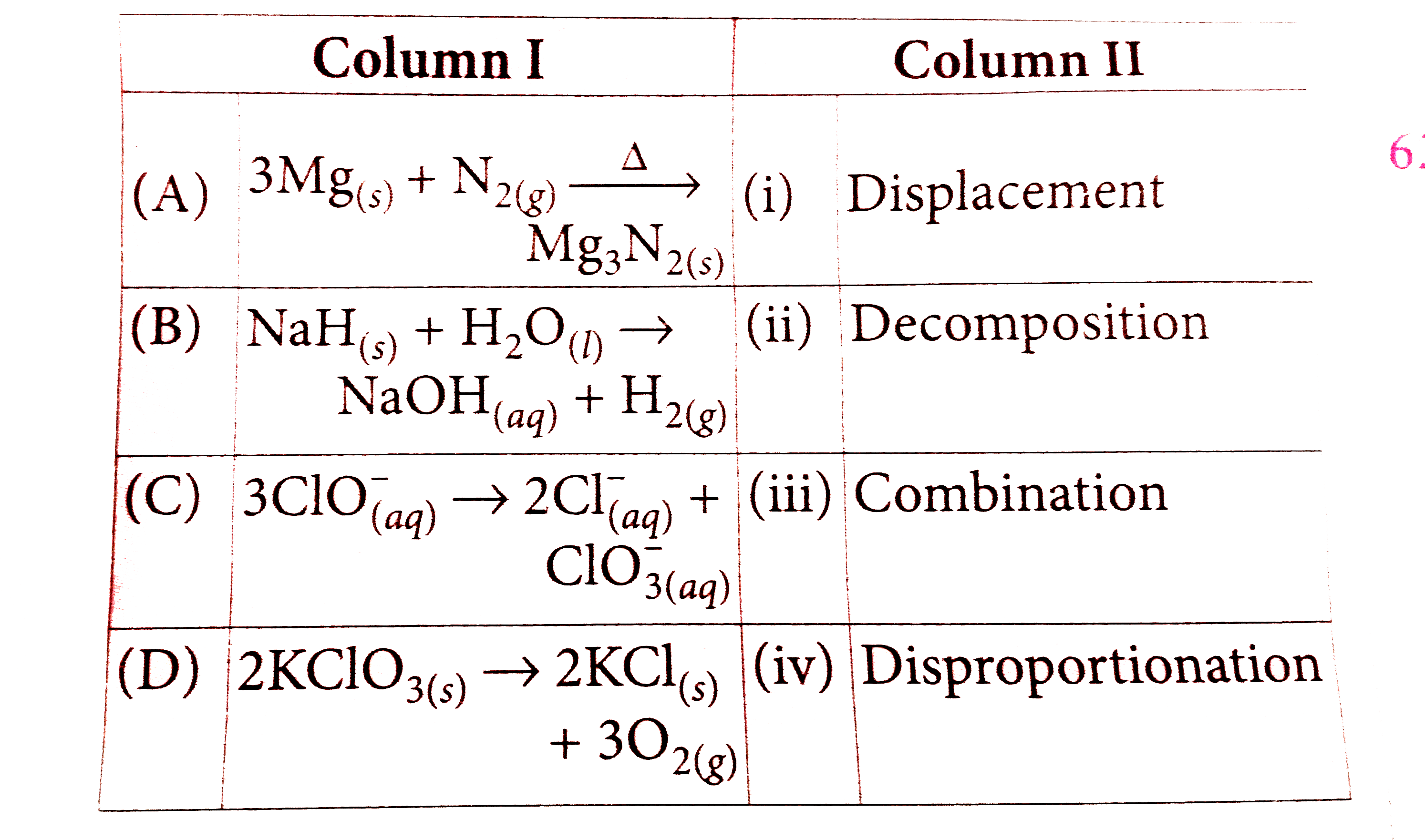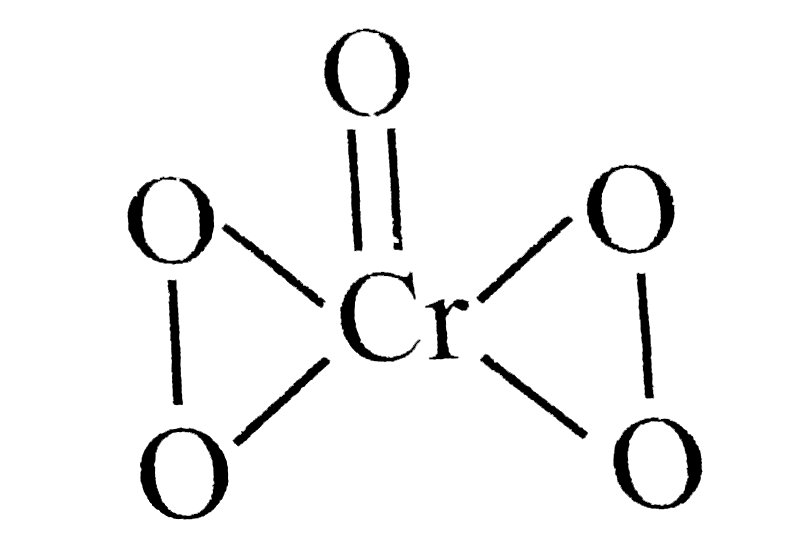Complete Solutions to Oxidation Number of chapter REDOX REACTIONS of Class 11 book with complete answers and questions
| Class 11 | CHEMISTRY |
| Chapter | REDOX REACTIONS |
| NCERT FINGERTIPS | Oxidation Number |
| Number Of Questions | 70 |
| Academic Year | 2023-24 |
Which of the following is not a rule for calculating oxidation number ?
View SolutionThe oxidation number of carbon in `CH_(2)Cl_(2)` is
View SolutionOxidation state of iron in `Fe(CO)_(4)` is
View SolutionThe oxidation states of sulphur in the anions `SO_(3)^(2-), S_(2)O_(4)^(2-)`, and `S_(2)O_(6)^(2-)` follow the order
View SolutionOxidation numbers of Mn in its compounds `MnCl_(2),Mn(OH)_(3),MnO_(2)` and `KMnO_(4)` respectively are:-
View SolutionArrange the oxides of nitrogen in increasing order of oxidation state of N from +1 to +5.
View SolutionThe oxidation state of `S` in `H_(2)S_(2)O_(8)` is
View SolutionMatch the compounds given in column I with oxidation states of carbon given in column II and mark the appropriate choice.
`{:(,"Column I",,"Column II"),("(A)",C_(6)H_(12)O_(6)," (i)"," +3"),("(B)",CHCl_(3)," (ii)"," -3"),("(C)",CH_(3)CH_(3)," (iii)"," +2"),("(D)",(CO OH)_(2)," (iv)"," 0"):}`
View SolutionAmong the following identify the species with an atom in `+6` oxidation state.
View SolutionThe pair of the compounds in which both the metals are in the highest possible oxidation state is,
View SolutionAn element that never has a positive oxidation state in any of its compounds is
View SolutionOxidation number if iodine in `IO_(3)^(-), IO_(4)^(-),KI and I_(2)` respectively are
View SolutionVarious oxidation states of few elements are mentioned. Which of the options is not correctly matched ?
View SolutionCarbon is in the lowest oxidation state in
View SolutionWhich of the following is a decreasing order of oxidation states of the central atoms?
View SolutionWhich compound amongst the following gas the highest oxidation number of Mn?
`KMnO_(4), K_(2)MnO_(2), MnO_(2) and Mn_(2)O_(3)`
View SolutionIn which of the following compounds oxidation state of chlorine has two different values?
View SolutionThe oxidation number of nitrogen in `(N_(2)H_(5))^(+)` is
View SolutionMark the correct statement from the following :
View SolutionWhich compound among the following has lowest oxidation number of chlorine ?
View SolutionWhich of the following oxidation numbers is not correctly matched ?
View SolutionExamples of few compounds in a particular oxidation state are given. Mark the example which is not correct.
View SolutionThe oxidation numbers of the sulphur atoms in pcroxy- monosulphuric acid `(H_(2)SO_(5))` and peroxydisulphuric acid `(H_(2)S_(2)O_(8))` are respectively.
View SolutionWhich is not true about the oxidation state of the following elements ?
View SolutionO.N of Fe in `K_(4)[Fe(CN)_(6)]` is
View SolutionArrange the following in increasing order of oxidation state of Ni.
`K_(2)[Ni(CN)_(4)],K_(2)[NiF_(6)],Ni(CO)_(4)`
View SolutionThe correct sequence of the oxidation state of underlined elements is
`Na_(2)[ul(Fe)(CN)_(5)NO],K_(2)ul(Ta)F_(7),Mg_(2)ul(P)_(2)O_(7),Na_(2)ul(S)_(4)O_(6),ul(N)_(3)H`
View SolutionWhat are the oxidation states of phosphorus in the following compounds ?
`H_(3)PO_(2),H_(3)PO_(4),Mg_(2)P_(2)O_(7),PH_(3),HPO_(3)`
View SolutionIn which of the following compounds carbon is in highest oxidation state ?
View SolutionThe oxidising state of molybdenum in its oxo complex species
`[Mo_(2)O_(4)(C_(2)H_(4))_(2)(H_(2)O)]^(2-)` is
View SolutionOxidation number of `P` in `Ba(H_(2)PO_(2))_(2)` is
View SolutionWhich of the following can act as oxidising as well as reducing agent?
View SolutionWhen a piece of sodium metal is dropped in water, hydrogen gas evolved because
View SolutionIn the reaction,
`I_(2)+2S_(2)O_(3)^(2-) rarr 2I^(-)+S_(4)O_(6)^(2-)`.
Equivalent wieght of iodine will be equal to
View SolutionIn the reaction `:Cl_(2)+OH^(-)rarrCl^(-)+ClO_(4)^(-)+H_(2)O` :-
View SolutionConsider the following reaction : `HCHO+2[Ag(NH_(3))_(2)]^(+)+3OH^(-)rarr2Ag+HCO O^(-)+4NH_(3)+2H_(2)O`
Which of the following statements regarding oxidation and reduction is correct?
View SolutionIdentify the compounds which are reduced and oxidised in the following reaction:
`3N_(2)H_(4)+2BrO_(3)^(-)rarr3N_(2)+2Br^(-)+6H_(2)O`
View SolutionIdentify the oxidant and reductant in the following redox reaction:
`2K_(2)MnO_(4)+CI_(2)rarr2KCI+2KMnO_(4)`
View SolutionIndicate whether the following conversions represent an oxidation, a reduction or none (neither oxidation nor reduction).
(i) `HClO_(3) ` to `HClO_(4) " " ` (ii) `NH_(4)^(+)` to `NH_(3)`
(iii) `NO_(2)` to `N_(2)O_(4) " " ` (iv) `HSO_(3)^(-)` to `SO_(4)^(2-)`
(v) `H_(2)O_(2)` to `H_(2)O`
View SolutionIn which of the following reactions, the underlined substance has been reduced ?
View SolutionA compound contains atoms A, B and C. the oxidation number of A is `+2`, of B is `+5` and of C is `-2`. The possible formula of the compound is
View SolutionConsider the following reactions,
(I) `2Mn_(2)O_(7) rarr 4MnO_(2) + 3O_(2)`
(II) `SnCl_(2) + 2FeCl_(3) rarr SnCl_(4) + 2FeCl_(2)`
View SolutionWhich of the following statements is correct regarding redox reactions ?
View SolutionIn the reacion ,
`3Br_(2)+6CO_(3)^(2-)+3H_(2)Orarr5Br^(-)+BrO_(3)^(-)+6HCO_(3)^(-)`
View SolutionGiven below is a redox reaction. Which of the following types the reaction belongs to ?
`CuSO_(4(aq))+Zn_((s)) rarr Cu_((s))+ZnSO_(4(aq))`
View SolutionIdentify the oxidant the reductant in the following reaction.
`Cl_(2)(g) + 2Br^(-)(aq) to 2Cl^(-)(aq) + Br_(2)(aq)`
View SolutionWhich of the following is a disproportionation reaction?
View SolutionMatch the column I with column II with the type of reaction and mark the appropriate choice.

View SolutionWhich of the following is not an example of disproportionation reaction ?
View SolutionWhite phosphorus reacts with caustic soda to form `PH_(3)` and `NaH_(2) PO_(2)`. This reaction is an example of
View SolutionWhat is the oxidation number of carbon in `C_(3)O_(2)` ( carbon suboxide ) ?
View SolutionThe oxidation number of Cr in `CrO(5)` which has the following structure is

View SolutionIn the conversion of ` Br_2` to `BrO_3^(-)` , the oxidation state of `Br` changes from.
View SolutionPermanganate (VII) ion, `MnO_(4)^(-)` oxidises `I^(-)` ion to `I_(2)` and gives manganese (IV) oxide `MnO_(2)` in basic medium. The skeletal ionic equation is given as `pMnO_(4(aq))^(-)+qI_((aq))^(-)+x H_(2)O_((l)) rarr rMnO_(2(s))+sI_(2(s))+yOH_((aq))^(-)`
The values of p, q, r and s are
View SolutionChoose correct statements (s) regarding the following reactions.
`Cr_(2)O_(7)^(2-)(aq)+3SO_(3)^(2-)(aq)+8H^(+) rarr 2Cr^(3+)(aq)+3SO_(4)^(2-)(aq)+4H_(2)O`
View SolutionThe `Mn^(3+)` ion is unstable in solution and undergoes disproportionation reaction to give `Mn^(+2), MnO_(2)`, and `H^(o+)` ion. Write a balanced ionic equation for the reaction.
View SolutionThe number of moles of `KMnO_(4)` reduced by `1 "mol of" KI` in alkaline medium is
View SolutionBalance the following equation by oxidation number method:
`K_(2)Cr_(2)O_(7)+FeSO_(4)+H_(2)SO_(4) to Cr_(2)(SO_(4))_(3)+Fe_(2)(SO_(4))+K_(2)SO_(4)+H_(2)O`
View SolutionWhich will be the value of x, y and z in the following equaton.
`xI_(2)+yOH^(-)rarrIO_(3)^(-)+zI+3H_(2)O`
View SolutionThe number of electrons involved in the conversion of `MnO_(4)^(-)` to `MnO_(2)` is
View SolutionThe values of coefficients to balance the following reaction are
`Cr(OH)_(3)+ClO^(-)+OH^(-) rarr CrO_(4)^(2-)+Cl^(-)+H_(2)O`
View SolutionThe stoichiometric constants for the reaction `pCu+qHNO_(3) rarr rCu(NO_(3))_(2)+sNO+tH_(2)O` p, q, r, s and t respectively are
View SolutionWhat is the correct representation of reaction occurring when HCl is heated with `MnO_(2)` ?
View SolutionWhen `KMnO_(4)` is reduced with oxalic acid in acidic solution, the oxidation number of `Mn` changes from
View SolutionWhen a mananous salt is fused with a mixture of `KNO_(3)` and and solid NaOH, the oxidation number of Mn change from +2 to:
View SolutionFor decolourisation of `1 "mol of" KMnO_(4)`, the moles of `H_(2)O_(2)` required is
View SolutionThe number of moles of `K_(2)Cr_(2)O_(7)` reduced by `1 mol` of `Sn^(2+)` ions is
View SolutionWhich of the following colour changes shown during redox titrations is not correct ?
View SolutionWhich of the following acts as a self-indicator ?
View SolutionWhich of the following are the common oxidising agents used in redox titrations ?
View Solution
Oxidation Number questions and complete solutions for chapter REDOX REACTIONS of MTG CHEMISTRY (HINGLISH) of Class 11